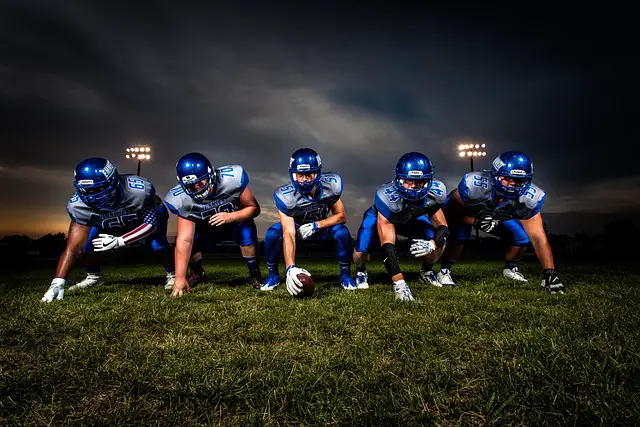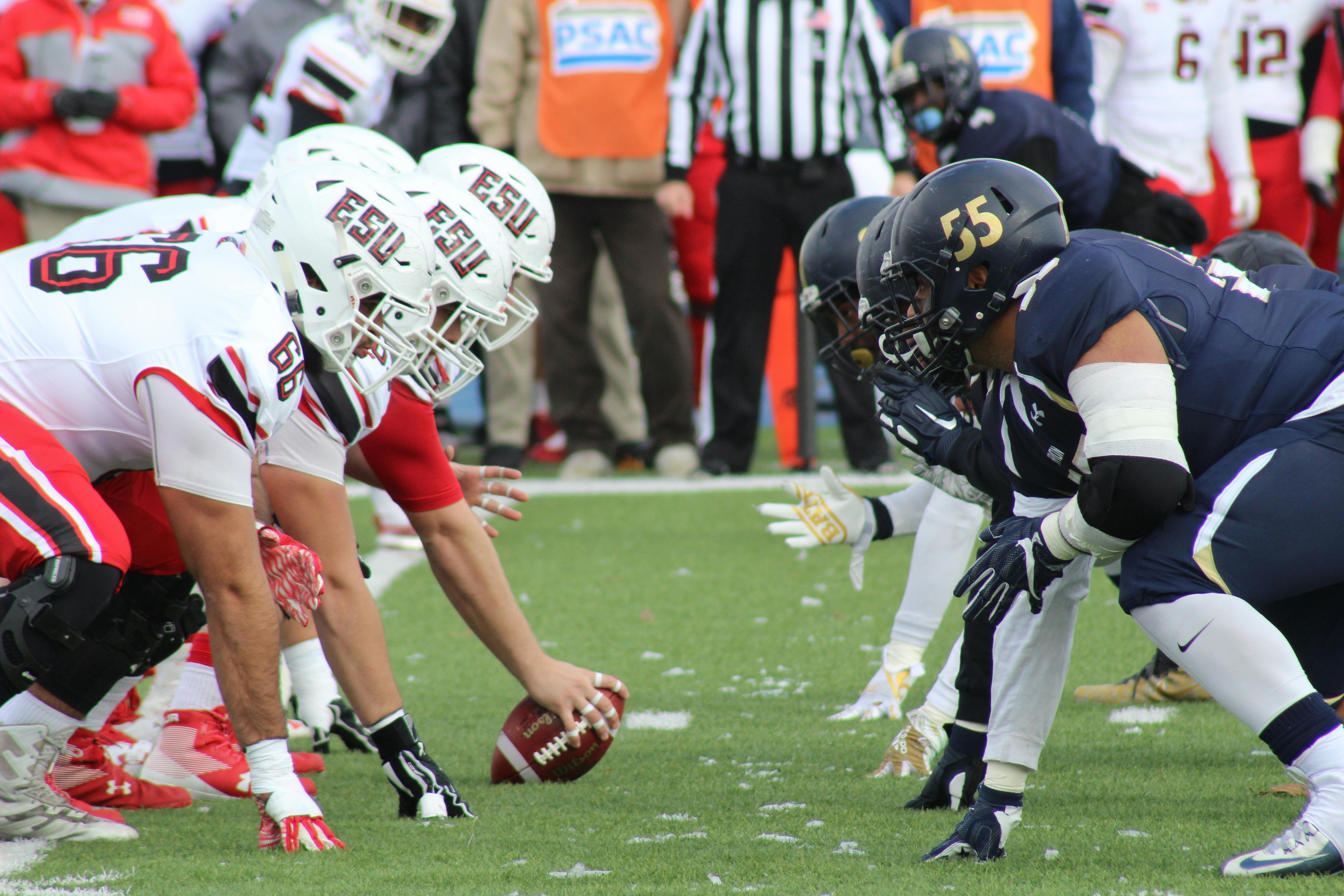Why Do Football Players Wear Tape On Their Arms

Football is a sport that requires strength, speed, and agility. One way that football players can help themselves stay safe and perform at their best is by wearing tape on their arms. This tape provides extra support to the muscles, joints, and ligaments of the arm while playing and prevents injuries such as strains and sprains. Tape also helps keep the arms secure in pads and uniforms while playing, allowing players to move more freely without worrying about their clothing shifting or bunching up. By wearing tape on their arms, football players are able to stay safe and perform at their highest level.The primary purpose of football players wearing tape on their arms is to support the muscles and ligaments of the arm and shoulder. The tape helps to provide stability and protection, which is especially important during contact sports like football. Additionally, the tape can also help to reduce inflammation in the affected area, as well as improve circulation and range of motion.
How Does Taping Help Football Players?
Taping is an important part of football preparation. It helps to protect players from injury and improve their performance on the field. Taping provides support, stability and protection for the joints and muscles of a football player. It can help prevent muscle strains, sprains, and other common injuries sustained during physical activity. It can also reduce the risk of soft tissue injuries, such as bruises and blisters, by providing padding around vulnerable areas. Taping also helps to keep the players’ joints in proper alignment which can help reduce pain and improve mobility during a game or practice session. In addition, taping can help to reduce fatigue by increasing blood flow to the muscles while playing. This allows players to perform at their peak levels for longer periods of time. Proper taping techniques are essential for any football player who wants to stay safe and perform at their best on the field.
Overall, taping is an important tool for football players that provides support, stability, protection from injury and improved performance on the field. It is important that coaches, trainers and athletes understand proper taping techniques so that they can use it safely and effectively when needed in order to get the most out of each game or practice session.
What Type of Tape do Football Players Use?
Football players often use a variety of tapes to help protect their bodies from the physical demands of the sport. The most commonly used type of tape is athletic or sports tape, which is designed to provide support and stability to joints and muscles. This type of tape is usually made from cotton or synthetic fabrics that are coated with an adhesive on one side. Athletic tape helps to reduce swelling and inflammation, as well as providing compression and support for muscles, ligaments, and tendons. It is also used by players to mark out formations during practice sessions. Other types of tape that are sometimes used by football players include kinesiology tape, which helps improve posture, balance and range of motion; neoprene rubber tape for added protection against injury; and pre-wrap underwrap for padding beneath protective gear.
Benefits of Taping Football Player’s Arms
Taping football player’s arms has many benefits for players on the field. It can help reduce the risk of injuries, improve performance, and protect players from contact. Taping also helps to support the muscles and joints in the arm and helps to prevent over-extension of the muscles.
One of the most important benefits of taping is that it provides extra support for the muscles and joints in a player’s arm which helps reduce the risk of injury. By supporting these areas, taping can help prevent sprains, strains, and dislocations that can happen during physical activity. Taping also helps to keep a player’s arms in proper alignment so that they are better able to maintain their balance during physical activity.
In addition to providing extra support, taping can also improve a player’s performance on the field. It gives players a better range of motion which allows them to move more freely. This increased range of motion increases speed and agility as well as increases accuracy when throwing or catching. Taping also provides extra stability when running or jumping which can help improve overall performance.
Finally, taping can help protect players from contact with other players on the field. By providing extra support and stability it reduces the risk of impact injuries such as bruises or abrasions caused by contact with another player or object on the field. Taping also helps to keep players’ arms in proper alignment which reduces the risk of accidental contact with an opponent’s body parts while playing defense or tackling another player during a game.
In conclusion, taping football player’s arms has many benefits both in terms of reducing injury risks and improving performance on the field. It provides extra support for muscles and joints, increases range of motion for greater speed and agility, and protects players from contact with other players or objects on the field.
Tape Improve Performance and Reduce Injury Risk in Football
Taping is a popular method used by football players to improve performance and reduce injury risk. Taping is used for a variety of reasons, from providing extra stability to muscles and joints, to providing additional support for athletes during intense physical activity. Taping can also help prevent excessive movement of the body, which can lead to further injury or discomfort.
Taping provides a range of benefits for football players, including improved balance and stability, increased joint stability and flexibility, improved muscular control and endurance, and increased circulation. Taped joints are less likely to be affected by excessive stretching or movement, as well as less likely to be injured during contact sports like football.
In addition to reducing the risk of injury, taping can also improve performance. Taping helps keep muscles warm which increases muscle strength and flexibility. It also provides compression which helps support the muscles during strenuous activity, allowing athletes to move more freely without risking injury. Additionally, taping helps protect weak areas from further damage due to overuse or overextension.
Tape is an important part of any football player’s equipment arsenal. It’s important to use the right type of tape based on individual needs in order to get the most benefit from it. Generally speaking, stretchy tape such as athletic tape or kinesiology tape is best for providing extra support while protecting against further injury or discomfort. The right type of tape can make all the difference in helping players perform their best on the field while staying safe from harm.
In conclusion, taping can be an effective way for football players to improve performance and reduce injury risk on the field. By using the right type of tape based on individual needs, athletes can benefit from increased joint stability, improved balance and stability, better muscular control and endurance, increased circulation and protection from further damage due to overuse or overextension. With proper taping techniques in place, football players can enjoy a safer game day experience with fewer injuries resulting from intense physical activity

Recommended Technique for Taping Football Player’s Arms
Taping football players’ arms is an essential part of a player’s equipment. It helps strengthen the joints and provide stability and support, reducing the risk of injuries. The tape also helps protect vulnerable areas on the arm from contact with other players or hard surfaces. To ensure the best protection and performance, it is important to use the correct technique when taping a football player’s arms.
The most effective way to tape a football player’s arms begins with wrapping a protective layer around the entire arm. This layer should be wide enough to cover any vulnerable areas, such as elbows or wrists, and should be applied in a spiral motion from the shoulder down to the wrist. Next, two layers of tape should be applied around each joint; one layer should go over the joint itself, while another layer should go around it. This helps provide additional stability and support while still allowing for natural movement.
Finally, any areas that are particularly prone to injury should be taped separately in order to provide extra protection. This includes areas such as elbows, wrists, or knuckles that may come into contact with other players or hard surfaces during play. The tape should be applied in a spiral motion around each area being protected, overlapping slightly on each pass in order to provide maximum coverage and stability.
Using this technique when taping football players’ arms will help ensure that they are adequately protected from injuries while still allowing them to perform at their best. Properly taped arms can also improve a player’s ability to grip objects like footballs or tackle pads and help prevent slips or falls during play. It is important for coaches and trainers to understand this recommended technique so that they can properly prepare their players for competition and reduce their risk of injury on the field.
How Does Tape Prevent Common Arm Injuries in Football?
Taping is one of the most common preventative measures for arm injuries in football. Taping helps to limit the amount of movement in the joints and muscles, which can help reduce the risk of a strain or sprain. By limiting movement, tape can provide additional support for the arm and help protect it from further injury. Taping can also help reduce swelling and inflammation, which is important for athletes recovering from an injury. It also provides additional protection from impact when tackling or blocking. Taping is also used on the hands to provide extra grip on the football, which can help prevent fumbles and drops. Overall, taping is a great way to protect arms from common football-related injuries while also helping to improve performance on the field.
Tape should be applied correctly to ensure that it provides the best protection possible. It’s important to use a good quality tape that is specifically designed for sports use. The tape should be applied in a figure-eight pattern around the joint being protected, with each loop overlapping slightly. The tape should be snug but not too tight as it needs to be able to move with the joint without restricting blood flow or causing discomfort. The tape should also be removed after each practice or game session as it will no longer provide any protection if it becomes loose or wet due to sweat or water exposure.
Taping arms can help reduce the risk of common arm injuries in football by providing extra support and limiting movement at key joints and muscles while still allowing some flexibility and range of motion when needed. It also helps improve grip on the ball by providing extra traction when catching or throwing passes, as well as helping reduce fumbles caused by slippery hands. However, taping must be done correctly in order to achieve these benefits – using high-quality tape that’s applied properly will ensure that players get maximum protection when playing football.
Other Uses for Tape on a Football Player’s Arms
Tape is an essential part of the equipment for any football player. It can be used to provide extra support to the arms and ankles, as well as to prevent injury. Aside from these more obvious uses, there are some lesser known ways that tape can help a player on the field. For example, tape can be used to keep jerseys tucked into pants or shorts, which helps the player maintain a streamlined look and remain focused on the game. Additionally, tape can be used to secure pads in place and ensure that they won’t move around during play. Lastly, tape is often used as an extra layer of protection against impacts from other players or hard surfaces like artificial turf.
Overall, tape serves many important purposes for football players both on and off the field. It is often an overlooked part of a football player’s equipment but it is essential for keeping them safe and comfortable while they play. With all the different ways that tape can be used, it’s no wonder why it has become such an integral part of football culture!

Conclusion
Football players wear tape on their arms for many different reasons. It can help to protect them from injury, keep them warm, or provide extra support during a game. It can also be used as part of a team’s branding or to make a statement. Whatever the reason, it is clear that football players use it to their advantage and benefit from doing so.
Taping arms is a common practice in football and one that has endured for many years. While the exact reasons for why players do this may vary from person to person, the benefits are clear and undeniable. Football players should continue to use this technique not only for its protective qualities but also for its aesthetic appeal. With the right taping technique, any team can look even more professional and intimidating on the field.
